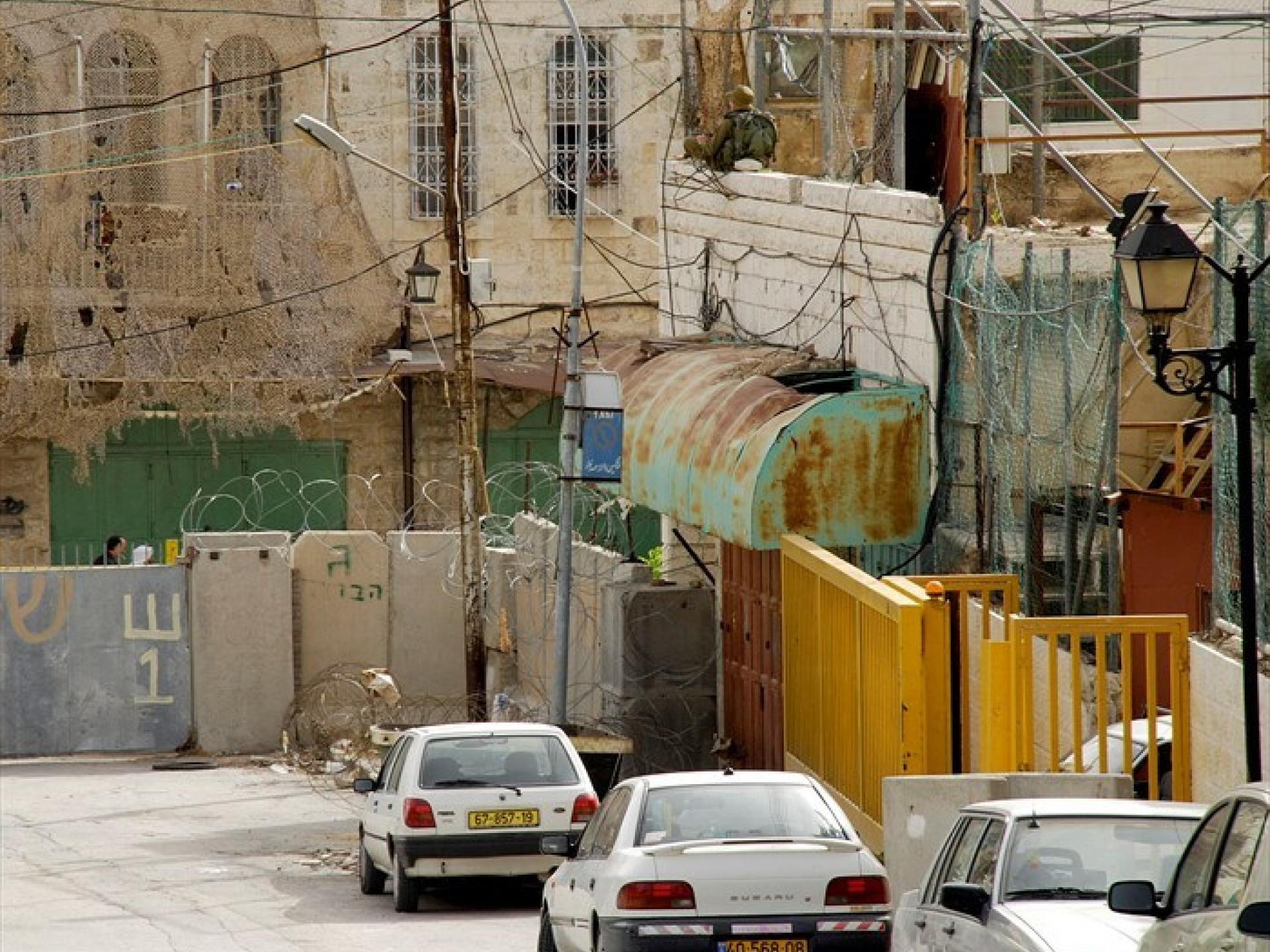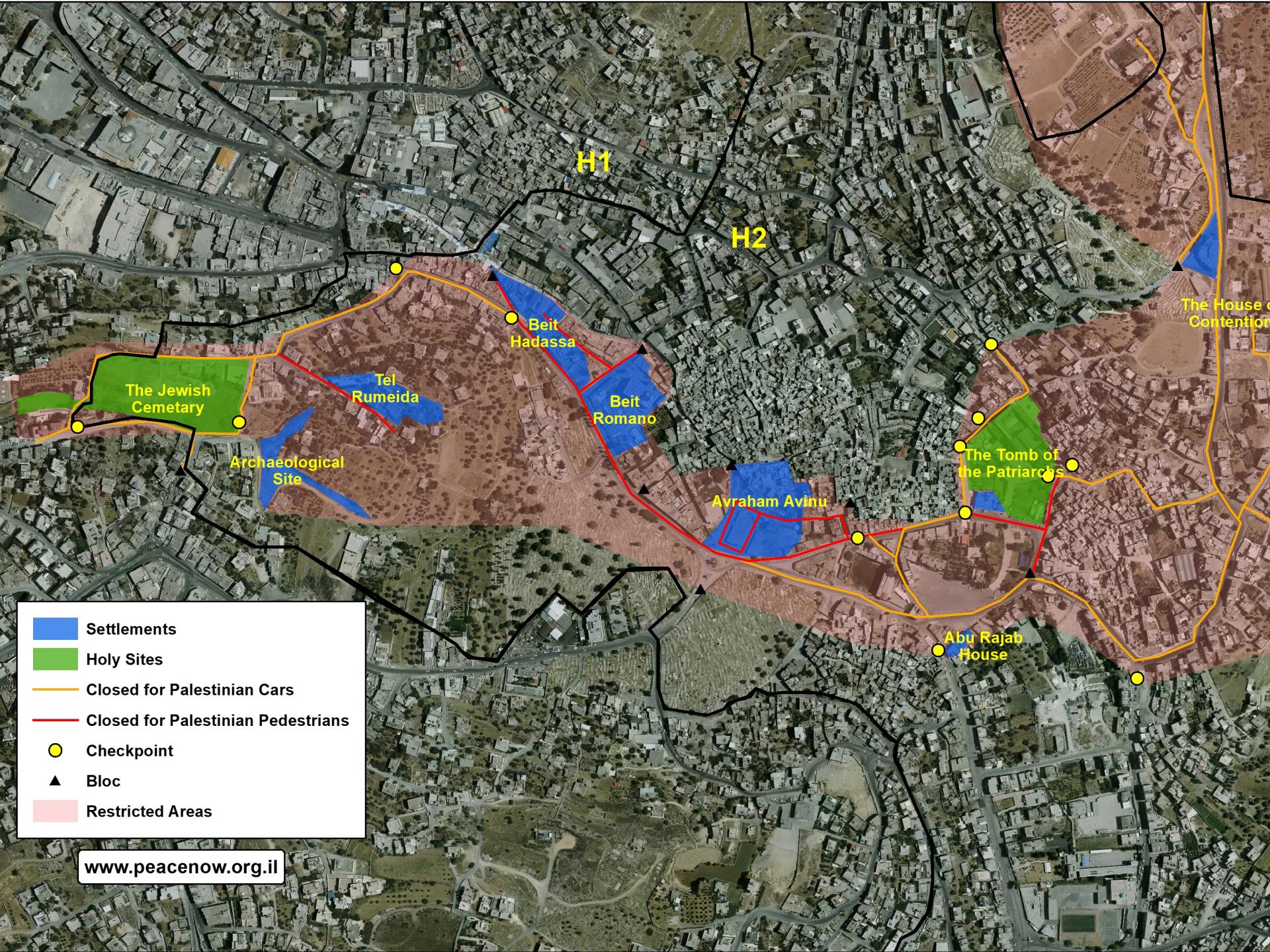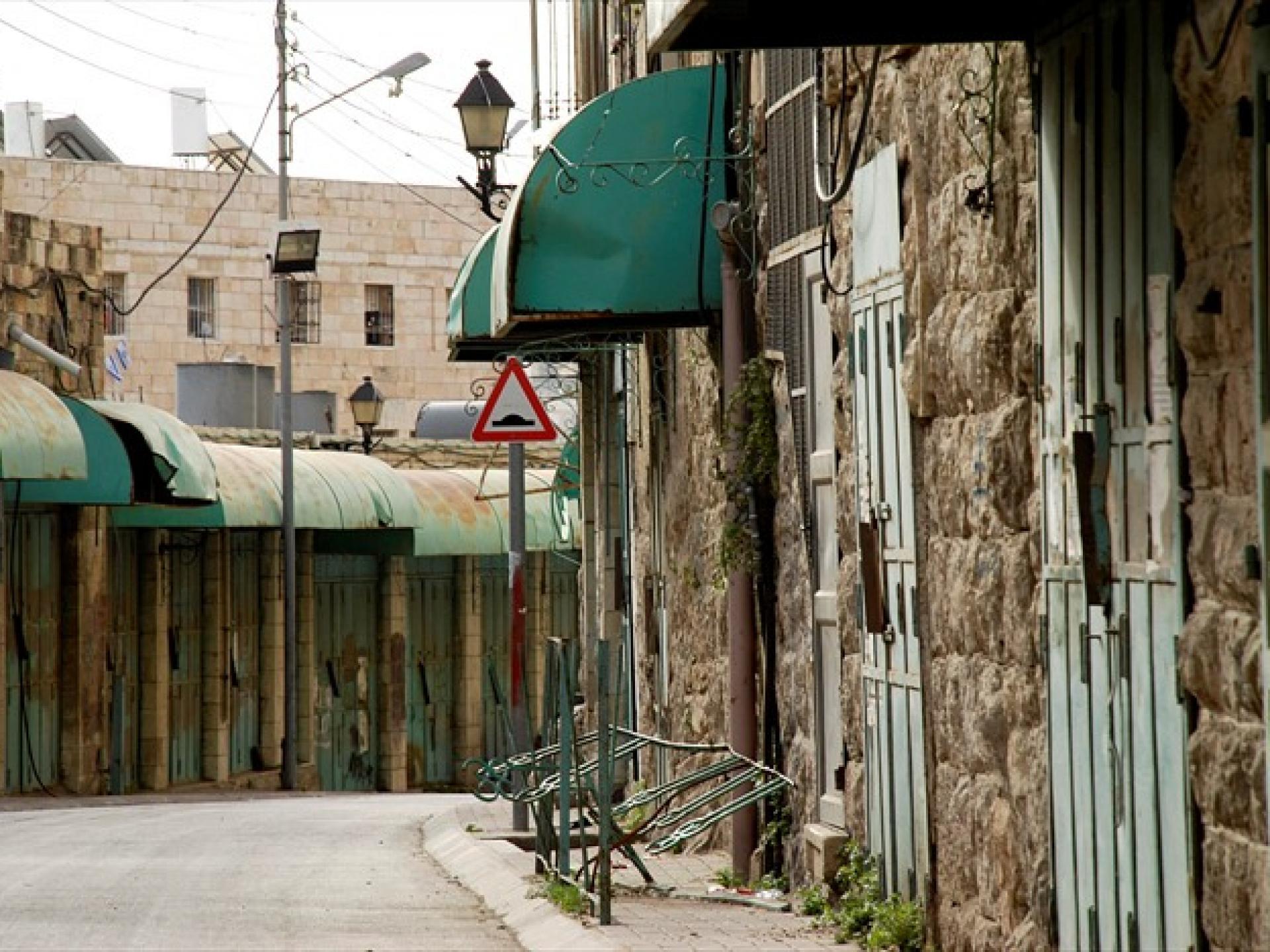
Background on the Entangled Situation in Hebron: The Wye Plantation Agreements (1997) divided the city of Hebron into two zones: H1 (80% of its area) to be controlled by the Palestinian Authority, and H2 (20%) controlled by the State of Israel. 170,000 Palestinians live in Hebron, of whom about 40,000 reside in H2. Permanent checkpoints placed between the two zones are manned around the clock. These checkpoints prevent Palestinians from crossing into H2 and Jews from crossing into H1. In addition, these checkpoints regulate the passage of permit-holders such as teachers and schoolchildren as well as Palestinian residents of the Old City of Hebron (located inside H2). Dozens of other barriers separate the zones, and the Israeli army maintains posts inside the Palestinian zone H1.
placed between the two zones are manned around the clock. These checkpoints prevent Palestinians from crossing into H2 and Jews from crossing into H1. In addition, these checkpoints regulate the passage of permit-holders such as teachers and schoolchildren as well as Palestinian residents of the Old City of Hebron (located inside H2). Dozens of other barriers separate the zones, and the Israeli army maintains posts inside the Palestinian zone H1.
The settlement of Kiryat Arba with a population of over 7,000 people, lies at the outskirts of Hebron. About 800 Jewish settlers currently reside inside the Old City of Hebron, in the neighborhoods of Avraham Avinu / the old market, Hadassah House, Romano House and Tel Rumeida (all of these were part of the old Jewish quarter), as well as Harsina Hill and the Hill of the Patriarchs. The Jewish settlers of Hebron constantly attempt to expand their hold by purchasing houses inside Palestinian neighborhoods, such as the Red House, the House of Dispute and the house at the Cave of the Patriarchs. In recent years, the “Jewish Committee of Hebron” has tried to receive a separate municipal status for all of these settlements. Furthermore, for the first time in fifteen years, the Israeli government has been promoting a plan to build 31 new dwellings for the Jewish settlers in Hebron.
Ongoing violence and terror are constant in Hebron – both by Jews and Palestinians. Since the massacre of Muslims at prayer, carried out by Baruch Goldstein inside the Ibrahimi Mosque (Cave of the Patriarchs) in 1994, a regime of both physical and legal segregation has been imposed upon the Palestinian majority by the Israeli army, protecting the Israeli settlers. The Palestinians pay the price for the settlers’ protection. This policy has caused the economic collapse of central Hebron, the closure of businesses and shops and the widespread evacuation of thousands of Palestinian residents.
of businesses and shops and the widespread evacuation of thousands of Palestinian residents.
OCHA, the UN Office for Coordinating Humanitarian Affairs, has counted 18 checkpoints constantly manned by soldiers, 14 checkpoints manned at times, and another 70 permanent barriers (concrete walls, concrete blocks and locked gates ) that separate the ancient center of the city, the heart of Hebron, from the rest of the city.
) that separate the ancient center of the city, the heart of Hebron, from the rest of the city.
The neighborhood of Tel Rumeida is situated at the top of Shuhada Street, in the western part of the Old City of Hebron (see map). In 1986 a new settlement was founded in the heart of this neighborhood. The location of this Jewish colony in the western part of the city enables the settlers to reinforce Israeli presence in one of the most sensitive areas of Hebron. In recent years, the Jewish settlers have been promoting the development of an archaeological park, which would create a new tourist route and add an extension of the Tel Rumeida settlement at its margins, in this way further isolating the Palestinians still living in the neighborhood.
In 2015 the Israeli army imposed an added draconian restriction on movement: Only Palestinians actually living in Tel Rumeida and on Shuhada Street are now allowed into the neighborhood. The many restrictions and bans make it nearly impossible to carry out the most basic activities of daily life such as shopping for food and other necessities, or carrying out basic renovations of the ancient dwellings. Over twenty houses in Tel Rumeida are not connected to the sanitation system and residents are forced to empty their septic tanks themselves, directly into their yards.
The settlers of Hebron are known to be notorious extremists, and the 1,200 Palestinian residents who still live in the neighborhood suffer repeated violent assaults by the settlers and lead their lives behind iron barred windows. At the same time the Jewish settlers enjoy the Israeli army’s full backing.
Four manned checkpoints form a strangling noose around Tel Rumeida, preventing Palestinians from accessing the neighborhood, controlling the lives of its non-Jewish residents through draconian restrictions. Thus, the communal fiber of this neighborhood is being destroyed and the residents’ ties with their surroundings become unraveled.
 MachsomWatch activity in the Hebron district began in 2004: weekly and at times bi-weekly shifts of our volunteers visit the various checkpoints and neighborhoods. Although our ability to affect the situation or help is very limited, we do provide a small ray of hope. Our visits enable Palestinians to meet civilian Israeli women who are not settlers and are not the military. We continue to monitor, document and expose the stark injustice, human suffering and rising level of violence that the Occupation imposes on residents.
MachsomWatch activity in the Hebron district began in 2004: weekly and at times bi-weekly shifts of our volunteers visit the various checkpoints and neighborhoods. Although our ability to affect the situation or help is very limited, we do provide a small ray of hope. Our visits enable Palestinians to meet civilian Israeli women who are not settlers and are not the military. We continue to monitor, document and expose the stark injustice, human suffering and rising level of violence that the Occupation imposes on residents.

MachsomWatch volunteers Rachel A. and Riki S. visited the isolated neighborhood of Tel Rumeida, and recorded their impressions
Now is the time to speak of a town that has become a prison.
Men, women and children live here, surrounded by a wall of houses.
These are the houses in which they were born and which strangers have invaded.
The army is everywhere –
in earthly matters, in sacred ritual, in public spaces and in every realm of the individual.
The spaces between the buildings are blocked by gates .
.
A number of checkpoints are meant to control and shut off life:
the “Beit Hadassah Checkpoint” from below
the “Tarpat Junction Checkpoint” from the side.
and the new “Archeological Garden Checkpoint” from above,
The residents of this ghetto, or better yet – sijen – prison, know the rules.
They have learned to navigate the system.
They know what is forbidden.
They know what is permitted.
Mainly, most everything they need to do is forbidden.
This place makes you cringe.
Your movements become slow and measured.
We enter the prison after driving up ghostly Shuhada Street. From the Ibrahimi Mosque Compound and the Cave of the Patriarchs – that has now become a military stronghold - all the way to Hadassah House. A soldier allows us to enter with our car. The street is totally empty. Soldiers only. Everything that was once a shop or dwelling is locked and shut. Hadassah House at one end and Tarpat Junction at the other. Parking in the deserted street only because you are a Jew is a harrowing experience.
We make our way to the section of Shuhada Street where the last remaining Palestinian residents still live. Most of the residents have fled. The woman born here who accompanies us on our tour says: “I’m not allowed” in answer to any question asked. She knows all those who have remained, living in the deserted houses. She accompanies us from one home to another.

To get from one house to the next you wander along trails
that are not really paths.
If you walk on the street, an army jeep may pop up at any point and ask questions.
If the answers are not deemed satisfactory,
uniformed, masked and armed soldiers
disembark and you will need to keep talking until
the forbidden and the permitted are made clear.You are better off trying to find the right roof,
or the unmarked path that crosses somebody else’s house.
No one asks why you are here.
You calculate and concentrate as you step between a rooftop to a gravel path, through a maze of inner courtyards.
There are no signs and nothing to lead you towards your destination.
In one of the houses an 80-year old woman resides alone. Her home is tidy, simply furnished and clean, its walls dilapidated. Most of the neighbors have left. The windows are barred for fear of the settlers and their children, who are in the habit of throwing stones and bottles occasionally, or wildly banging on the door. Her daughter, living in another neighborhood, comes daily to take care of her needs. She is lucky enough to be on the list which includes only first-degree relatives. Sons and daughters. Some of them refuse however to be on it and be subject to the Israeli army’s graces. At times, refusal is a form of resistance, at other times fear is the cause. In any case, they cannot take care of their old and ailing parents. This daughter worries. Her mother is alone most hours of the day and night.
Should you decide to invite family or friends to visit you at home,
to gather for festivities and mourning
you cannot.
An outsider doesn’t have an entry permit to this jail town,
so you are bound to celebrate and mourn in seclusion.
The house next door is inhabited by a family that runs a kindergarten one roof away, to which climbing is forbidden by the steps leading up from Shuhada Street – if one is Palestinian, of course… There are hidden ways to reach the kindergarten. One of them is through the roof. (watch the video https://youtu.be/0QsFMeJYPag) And the roof, like other roofs, is not quite a track. It’s like crossing a river on stepping stones that happen to be there. In the kindergarten the merriment of young children reigns.
They were born into this.
so have their mothers,
they were born at various phases of this place turning into one big prison.
Even when they’re small,
even when they’re afraid,
they must cross between the soldiers and the violent settler-colonists
(Noam Federman, Baruch Marzel and their ilk)
and climb the broken steps leading to the kindergartens and schools, unaccompanied by parents.
Further on, near the kindergarten, is the elementary school (up to the 9th grade) called Kartoba (Cordoba). Our companion’s 11-year old daughter joins us for the trek. She crosses the checkpoint every morning. She has grown used to it. The checkpoint itself doesn’t scare her – she is only afraid of the dog that might bite her, which has already happened once.
We enter a house with a lovely entrance, its interior furnished, handsome and respectable, and we are warmly welcomed. Grapes, peanuts, pistachios and a woman so glad to meet different Jews (different from the settler and soldiers she sees there habitually). So glad it is heart-rending. And the two tell us about the Jews from the PsychoActive organization who come there to be with them, and they try to explain to us how their everyday lives are run.
It takes an hour to go shopping for the most basic stuff,
an hour if one wishes to pick up a child from kindergarten or school.
The shorter way is blocked by fences and soldiers with rifles.
And clearly one cannot carry the stuff from Palestinian-controlled Hebron all the way to the Sijen (prison) needing someone to help along the way.
The children?
Anyone who can, leaves.
They went to Jerusalem, to Beit Hanina.
Yes, they would like to come back, one day...
Then we walk up to see the new Archeological Garden Checkpoint that brought us here. It prevents entrance and exit of anyone that doesn’t live here. In fact, even those who live in the neighborhood are not allowed to drive in. We try to understand how can it be that a residential neighborhood is closed off like this from the outside world? What have its inhabitants done; what crime have they committed?
From up the hill we observe the abandoned Shuhada Street and the ruins of the Old City, the locked houses and the shut-down shops. But next to one home, a Palestinian flag flies proudly, and anti-occupation graffiti welcomes us.
And just as we have learned over the years in MachsomWatch, instead of lamenting about what is, we sat with our companion and asked ourselves what we could do together….
